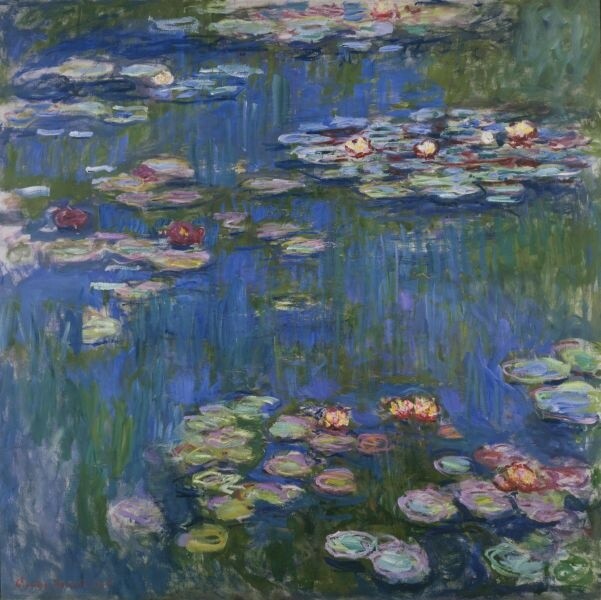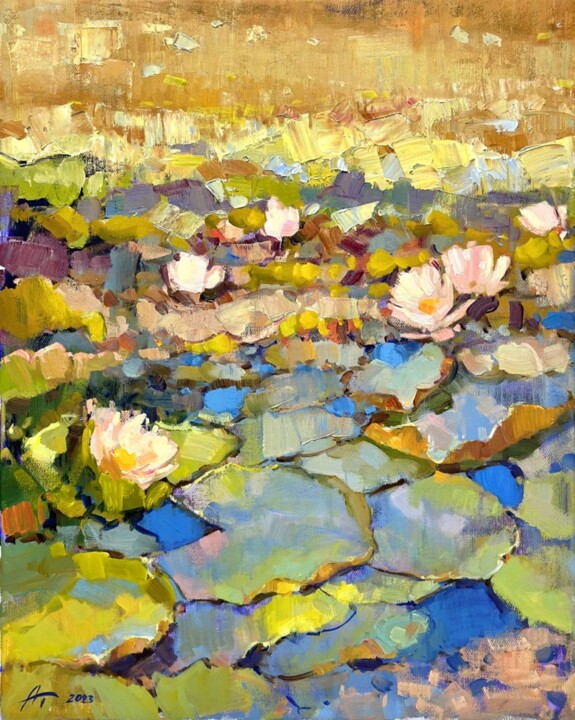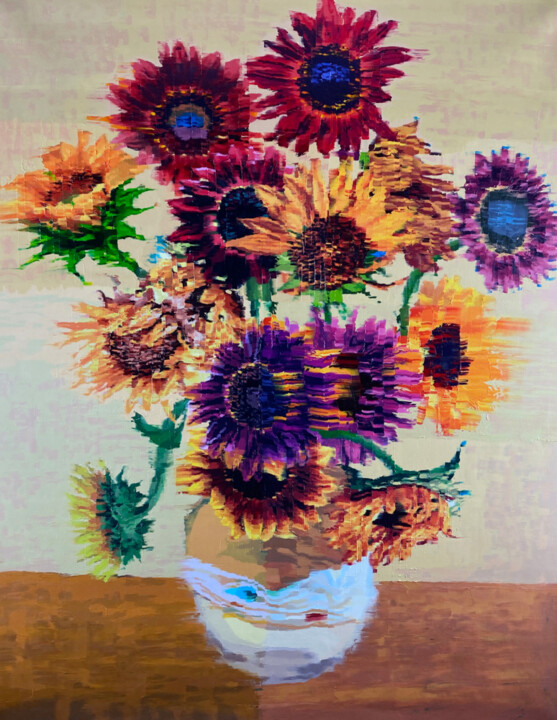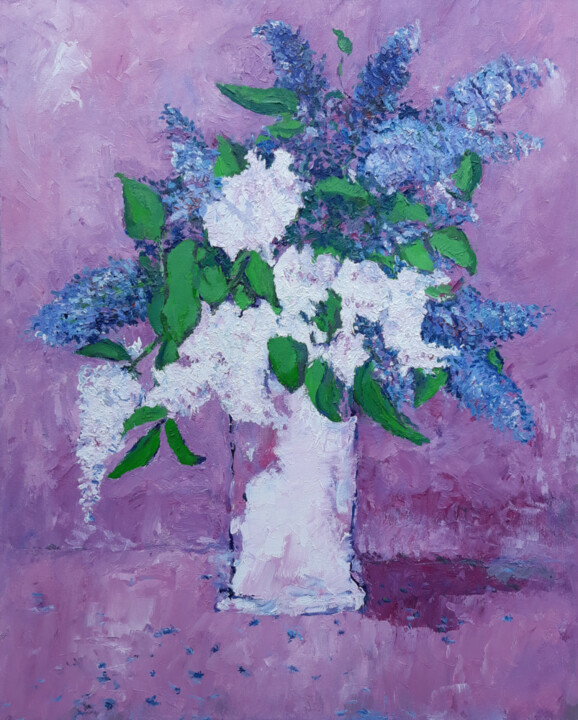 Claude Monet, Water Lilies, 1916. National Museum of Western Art, Tokyo.
Claude Monet, Water Lilies, 1916. National Museum of Western Art, Tokyo.
Suddenly, you find yourself within one of Monet’s most famous water lilies, where you are enveloped by an endless expanse of gently swaying greens and blues, feeling cradled by the breeze of a summer afternoon. The brushstrokes that depict nature on the canvas are fluid, while the light filtered through the petals and leaves creates a play of reflections on the water, as if trying to capture the eternal moment of a fleeting instant.
But just as you surrender to the calm of Giverny’s garden, you are suddenly captivated by the intense fragrance of Pierre-Joseph Redouté’s watercolors, where every rose petal seems to immortalize a love for nature that is almost sacred. The delicacy of these forms envelops you, allowing you to become part of the very essence of beauty.
However, time is fleeting, and soon after you find yourself in front of Van Gogh’s famous Sunflowers, a masterpiece where the intense yellow and gold hues powerfully stand out from the canvas, as if animated by an internal light. Moreover, the artist’s swift and decisive brushstrokes give the flowers an almost palpable vitality, transforming them into symbols of energy and life.
 Flowers painted by Pierre-Joseph Redouté.
Flowers painted by Pierre-Joseph Redouté.
 Claude Monet, The Poppies, 1873. Oil on canvas. Musée d'Orsay, Paris.
Claude Monet, The Poppies, 1873. Oil on canvas. Musée d'Orsay, Paris.
It is time to turn and admire White Lilacs in a Crystal Vase by Édouard Manet, a work that captures this particular flower species, carefully arranged in an elegant, refined, and luminous container. Manet captures the delicate essence of these flowers, highlighting their light and pure tones by placing them against a dark background. The result is a celebration of the simplicity of the subject, as well as a tribute to the ephemeral beauty of nature, intended as an invitation to contemplate the tranquility and serenity of the floral world.
Finally, the long narrative of art history brings us to the vivid red of Claude Monet's poppies, portrayed in his eponymous 1873 painting, where they appear to the viewer like flames blazing under the summer sun, swaying in the wind in a seemingly endless field.
And it is through this journey among immortal masterpieces that the contemporary narrative takes shape, leading us to the works of the artists of Artmajeur. These artists, with their personal styles, continue to explore and reinterpret the most popular flowers in the history of art – water lilies, roses, sunflowers, lilacs, and poppies – once again inviting you to discover how nature remains an inexhaustible source of inspiration and wonder for the visual arts. Now, let's see their works and compare them!
 Lilies (2023) Painting by Andrei Belaichuk.
Lilies (2023) Painting by Andrei Belaichuk.
 O. Balbyshev 'Let's Swim Naked!' - EDITIONED PRINT 01/50 (2022) Print by Oleksandr Balbyshev
O. Balbyshev 'Let's Swim Naked!' - EDITIONED PRINT 01/50 (2022) Print by Oleksandr Balbyshev
From Monet to Balbyshev, Passing through Belaichuk
The masterpiece by Monet that opens this narrative, displayed at the National Museum of Western Art in Tokyo, is a sublime example of Impressionism. His depiction of water lilies is characterized by delicate and vibrant brushstrokes that capture light and reflections on the water in an ethereal manner. The French master explored natural beauty with an approach that prioritized visual impressions and fleeting moments rather than precise details. The result is a canvas where colors blend softly, creating a landscape that resembles a blurred dream.
Belaichuk's contemporary work, on the other hand, draws from Monet's Impressionist style but updates it with a more modern and lively language. While Monet aimed to capture light and atmosphere, this Artmajeur painter emphasizes bright colors and strong contrasts. Belaichuk's composition features water lilies that seem to explode with color, with vivid flowers standing out against the more delicate hues of the lake. Unlike classical Impressionism, which sought to capture the essence of a moment, this painting conveys a more direct and vibrant energy, designed to immerse the viewer in a lively, dynamic, and playful landscape.
Balbyshev's perspective, however, radically breaks with the tradition upheld by previous Impressionist models by placing a male nude at the center of the scene. The artist not only draws inspiration from Monet's water lilies but uses them as a backdrop for a reflection on the representation of the male body in art. The male form, rarely explored as a sensual subject in art compared to the female nude, is here highlighted and celebrated. Thus, Balbyshev's work is not just a tribute to Monet's water lilies but also a critique and reimagining of how male sensuality and beauty have been historically undervalued in art.

Yellow Roses (2024) Painting by Valeri Tsvetkov.
 Yellow Roses (2022) Painting by Rosi Roys
Yellow Roses (2022) Painting by Rosi Roys
Roses and the Evolution of Figurativism
Returning to the roses of the renowned illustrator Pierre-Joseph Redouté, they represent a classic example of botanical precision. Redouté, known as the "Raphael of flowers," captured the beauty of blossoms with meticulous attention to detail. In this sense, his roses are depicted with almost scientific accuracy: every petal, every leaf, every shade of color is rendered with extreme care, aimed at faithfully documenting the natural form.
Regarding the painting by Valeri Tsvetkov, we observe an evolution toward a realism that, while maintaining detail accuracy, also focuses on expression and atmosphere. Tsvetkov's roses are portrayed with a strong sense of three-dimensionality, where light and shadow play a crucial role in bringing the flowers to life. Unlike Redouté's botanical precision, this Artmajeur artist utilizes oil painting to explore the velvety texture of the petals and their soft interplay of lights, creating a work that, though realistic, seeks to evoke emotions and feelings of warmth and serenity. Here, precision slightly yields to the poetry of representation, striving to convey not only the physical appearance but also the emotional essence of the flowers.
Rosi Roys's work, on the other hand, represents a further step toward abstraction. The painter almost entirely abandons detailed representation to focus on color and texture. The roses, though still recognizable, are deconstructed into vigorous and gestural brushstrokes, with colors that seem to explode across the canvas.
 Girasoli (2022) Dipinto di Gerry Chapleski
Girasoli (2022) Dipinto di Gerry Chapleski
 Sunflowers (2024) Painting by Anna Mamonkina
Sunflowers (2024) Painting by Anna Mamonkina
Vincent van Gogh's Influence in 2024
The two works above, though different in their interpretations and settings, offer an intriguing figurative narrative that connects to the influences of great masters of the past, particularly Vincent van Gogh.
The first painting by Gerry Chapleski immediately brings to mind the famous Sunflowers masterpiece by the aforementioned Dutch master. However, the Artmajeur artist introduces a modern approach by manipulating oil paint, creating a textured and dynamic effect that differs from the older brushstrokes of Van Gogh. This technique gives the flowers an almost digital appearance, as if the forms have been deconstructed and then reassembled in a way that makes the flowers seem to float against the background.
Anna Mamonkina's work, on the other hand, transports the sunflowers into a completely different context, reminiscent of a new Starry Night. Here, the sunflowers are no longer the focal point of a static composition but are placed in a vast rural landscape awakening to the first light of dawn. In this time frame, the contrast between the growing daylight and the stars still shining in the sky creates a dreamlike atmosphere, evoking a connection between the earth and the universe. It is as if the sunflowers themselves are participating in this transition between night and day, paying homage to the continuous beauty and hope that the new day brings.
 Lilacs in White Vase (2023) Painting by Animesh Roy
Lilacs in White Vase (2023) Painting by Animesh Roy
 Lilac (2016) Painting by Ivan Kolisnyk
Lilac (2016) Painting by Ivan Kolisnyk
What Would Édouard Manet Think?
Here’s how a stylistic comparison between the two works above might sound, imagining Édouard Manet, the creator of White Lilacs in a Crystal Vase, making the comparison:
"Observing these two modern works, I can’t help but reflect on how art has continued to evolve in its treatment of floral themes. When I painted White Lilacs in a Crystal Vase between 1882 and 1883, I aimed to capture the purity and delicacy of the flowers through a combination of realism and a sense of immediacy. The crystal vase, with its transparency, served as the perfect backdrop to elevate the lilacs, almost as if they were suspended in the air, weightless.
In Animesh Roy’s painting, I notice how the subject may trace its origins to my work, though the artist has expressed himself through the language of contemporary Impressionism. Roy uses thicker brushstrokes, with a certain abandon in the application of color, where the shapes of the flowers are more suggested than defined, giving the piece a sense of movement and vitality. However, unlike my approach, where the transparency of the vase played a central role, this Artmajeur artist opts for an opaque white vase, which almost blends into the background, shifting all the attention to the intense colors of the flowers and leaves.
Moving on to Ivan Kolisnyk’s work, I think it shows thicker and more defined contours compared to Roy’s. The color is applied in vibrant patches, with bold brushstrokes that give a sense of texture and material density, imparting an almost tactile presence to the flowers. Additionally, unlike Roy, who prefers a more abstract and indefinite background, Kolisnyk adopts a more realistic one, grounding the composition in a more concrete reality. This choice seems to accentuate the contrast between the more expressive painterly approach to the flowers and the surrounding environment, creating a balance between subjective vision and objective representation."

Poppies in the Mountains (2024) Painting by Kosta Morr
A New Field of Poppies
Where have the figures gone that once animated Monet’s landscape of poppies?
In Kosta Morr’s representation, the poppies are still present, bright and vibrant under the shining sun, but the gentle hills that once hosted the leisurely strolls of mother and child have been replaced by imposing, stylized mountains, while the sky is rendered in bold, graphic tones. Nature is indeed powerful and dominant, but the human element is entirely absent.
As we gaze at the scene, it almost seems as if Monet’s earlier figures have been swallowed by the landscape itself or have chosen to leave this scene for some more intimate and hidden place. Kosta Morr, with his graphic style and vivid colors, creates a landscape that celebrates nature in a more "abstract" and idealized form, where the human role is reduced to that of a spectator rather than a participant. This can be connected to the idea that in Morr's work, nature is strong, almost invincible, whereas in Monet's, it was gentler, ready to welcome and embrace human presence.
This comparison between the two works prompts us to reflect on how the relationship between humans and nature has changed in art. In Monet’s work, humans were an integral part of the landscape, attentive and respectful observers, while in Morr’s, nature seems to overshadow humans, reduced to shadows that do not appear on the canvas. Perhaps Monet’s figures are still there, hidden among the hills and fields, or perhaps they have simply given way to a nature that now demands to be seen and celebrated in all its grand solitude.


 Olimpia Gaia Martinelli
Olimpia Gaia Martinelli















































